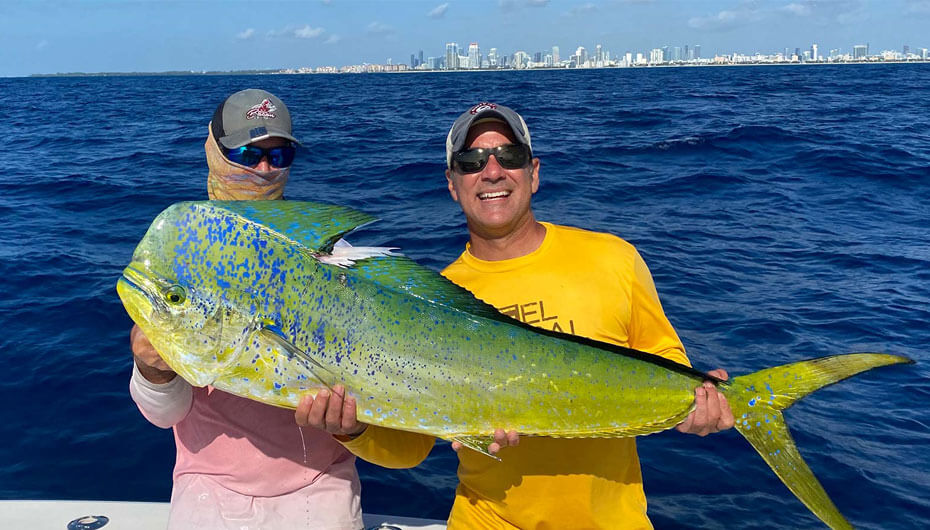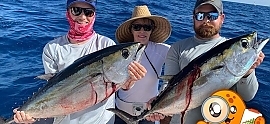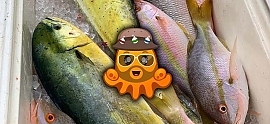Finding clients online for your fishing guide business can be as tricky as landing a big fish. But with smart local SEO strategies, you can turn your website into a hotspot for potential customers. Let's dive deep into how local SEO can help your fishing guide business reel in more bookings.
What is Local SEO for Fishing Guides?
Local SEO for fishing guides is like knowing where the fish are biting. It's about making your business easy to find when people search for fishing trips in your area. This means showing up in local search results when anglers are looking for guides nearby. According to BrightLocal's Local Consumer Review Survey, 93% of consumers used the internet to find a local business in 2020, highlighting the importance of local SEO for businesses like fishing guides.
Why Local SEO Matters for Fishing Guides
Google says nearly half of all searches are looking for local information. For fishing guides, this is huge. When someone searches "fishing guides near me" or "bass fishing trips in [Your Area]," you want your business to be right at the top, like the biggest catch of the day.
7 Ways Local SEO Helps Fishing Guides
A study by Google found that 76% of people who search for something nearby on their smartphone visit a related business within a day. This statistic underscores the importance of the following ways local SEO can help fishing guides:
- Gets You Noticed: Local SEO puts your business on the map. When anglers search for guides in your area, good SEO makes you as easy to spot as a lighthouse.
- Brings in Serious Customers: By using the right keywords, you'll attract people who are ready to book a trip. It's like using the perfect bait for the fish you want to catch.
- Works Around the Clock: Your website and online listings work 24/7, even when you're out on the water. It's like having a helper always looking for new clients.
- Beats the Competition: Many fishing guides aren't using SEO well. With a good strategy, you'll be catching clients while others are still setting up their rods.
- Saves Money: Compared to traditional ads, local SEO gives you more bang for your buck. It's like using a net instead of a single line - you catch more with less effort.
- Builds Trust: Good online presence, with positive reviews and helpful info, makes people trust you. It's like showing off your best catches - it proves you know what you're doing.
- Reaches Mobile Users: Most Google searches now happen on phones. Good local SEO ensures you're visible to people planning trips on their mobiles.
Local SEO Strategies for Fishing Guides
Implementing effective local SEO strategies is crucial. HubSpot reports that 72% of consumers who did a local search visited a store within five miles. For fishing guides, this translates to potential clients in your area finding and choosing your services.
Set Up Your Google Business Profile
Think of your Google Business Profile as your online dock. It's often the first place potential clients see you. Make sure it's in top shape with:
- Correct name, address, and phone number
- Great photos of your boat, gear, and happy clients with their catches
- A clear description of your services and types of trips
- Regular updates about fishing conditions and special offers
- Lots of good reviews - they're like fish stories that attract more anglers
Create Pages for Each Fishing Spot
If you guide at different lakes or rivers, make a separate page for each one. This helps you show up in searches like "fly fishing guide on the Kenai River" or "deep sea fishing in the Gulf of Mexico."
Get and Use Customer Reviews
Good reviews are like trophies on your wall - they show off your skills and attract more clients. Ask happy customers to leave reviews on Google, Facebook, and fishing websites. If you’re also in the marine services industry, like Boat Repair Miami, local SEO can be the difference between getting buried or getting booked. Their visibility in competitive markets like South Florida shows just how powerful strong local rankings can be for service-based businesses.
Build Links with Local Businesses
Connect with other local businesses like bait shops, resorts, or outdoor stores. If they link to your website, it's like getting a recommendation from a trusted friend.
Optimize for Voice Search
More people are using voice assistants to search. Think about how someone might ask about fishing guides: "Hey Siri, find me a bass fishing guide near Lake Okeechobee."
Bait Your Hook with Good Information
Creating valuable content is essential for SEO success. Content Marketing Institute found that 70% of consumers feel closer to a company as a result of content marketing. For fishing guides, this means providing informative and engaging content can help build relationships with potential clients. Create content that hooks readers and reels them in, like:
- Seasonal fishing reports for your area
- Tips for beginners on fishing techniques
- Info about local fish species and their habits
- Stories of big catches or exciting trips
- Local fishing rules and license info
- Gear reviews and recommendations
- Info on conservation and sustainable fishing
- How local weather affects fishing
- Recipes for cooking local fish
Technical SEO (Fine-Tuning Your Gear)
Just like maintaining your fishing gear, these technical bits keep your website running smoothly. According to Search Engine Journal, Google's Core Web Vitals, which measure site speed and user experience, became ranking factors in 2021. This makes technical SEO more important than ever:
Make Your Site Mobile-Friendly
Many people plan trips on their phones, so your site should work well on small screens.
Speed Up Your Website
A fast website keeps visitors interested. Use tools like Google PageSpeed Insights to make your site quicker.
Use Schema Markup
Here's a revised explanation of schema markup with an example, but without a full code snippet:
Use Schema Markup
This is like tagging your catch. It helps search engines understand your content better, which can improve how you show up in search results. Schema markup is a specific code that you add to your website's HTML to provide search engines with detailed information about your business.
For example, as a fishing guide, you might use schema markup to tell search engines:
- That you offer a tourism service, specifically fishing guide services
- Your business name and description
- The area you serve (like "Lake Michigan")
- Your typical pricing and what it includes
- Your business address and contact information
- The types of fish your clients can expect to catch
By providing this structured data, you're essentially giving search engines a clear, organized summary of your business. This can lead to better visibility in search results, and may even result in rich snippets - those detailed information boxes that sometimes appear at the top of search results. For a fishing guide, this could mean your business hours, contact info, and even customer ratings appearing directly in search results, making it easier for potential clients to choose your services.
Casting a Wider Net With Social Media
Social media platforms are like extra fishing spots - each one can help you connect with potential clients. Sprout Social reports that 80% of consumers expect brands to interact with them on social media. For fishing guides, this means that an active social media presence can significantly increase engagement and bookings:
Instagram is a visual platform perfect for showcasing the excitement and beauty of fishing trips. Use it to create a compelling visual story of your guide services:
- Post daily catch photos, highlighting the size and species of fish
- Share scenic shots of sunrise/sunset on the water to capture the atmosphere
- Create before-and-after series showing the transformation of novice anglers into confident fishers
- Use Instagram Stories to give real-time updates on weather conditions and fish activity
- Post short reels demonstrating fishing techniques or gear tips
Use local hashtags like #LakeMichiganFishing or #FloridaKeysFishing to attract nearby anglers. Incorporate popular fishing hashtags such as #FishingLife, #CatchAndRelease, or #BassFishing to reach a wider audience. Consider running Instagram contests, like "Best Catch of the Month," to encourage engagement and user-generated content.
YouTube
YouTube allows you to show off your expertise and the fishing experience in-depth. Create a variety of video content to attract and educate potential clients:
- Produce "How-To" videos on fishing techniques specific to your area
- Create virtual tours of your boat and equipment
- Film client testimonials and trip highlights
- Make seasonal fishing reports discussing current conditions and forecasts
- Develop a series on local fish species, their habits, and best catching methods
Optimize your videos for SEO by using descriptive titles like "Complete Guide to Bass Fishing in Lake Okeechobee" or "Top 5 Lures for Salmon Fishing in Alaska." Write detailed descriptions including relevant keywords, and use tags to help your videos appear in search results. Consider creating playlists for different topics or skill levels to keep viewers engaged with your content longer.
Facebook is excellent for building a community and engaging directly with potential and past clients. Use it to share a mix of informative and promotional content:
- Post daily fishing reports and photos of recent catches
- Share articles on fishing regulations, conservation efforts, or industry news
- Create polls asking followers about their favorite fishing spots or techniques
- Use Facebook Live to answer questions or give a real-time look at fishing conditions
- Promote special offers or last-minute availability for trips
Start a Facebook Group for local anglers or your past clients. This can become a hub for sharing tips, arranging meetups, and fostering a sense of community. Use Facebook Events to promote fishing tournaments, workshops, or special guided trips. Encourage clients to leave reviews on your Facebook page, and respond promptly to all comments and messages to build trust and engagement.
For all platforms, consistency is key. Develop a content calendar to ensure regular posting, and use scheduling tools to maintain activity even when you're out on the water. Remember to cross-promote your content across platforms to maximize reach and engagement.
Measuring Your SEO Success
Keep track of these things to see how well your SEO is working. Statista reports that 67% of marketers use organic traffic as a key SEO KPI. For fishing guides, this and other metrics can provide valuable insights:
- More visitors to your website from local searches
- More people booking trips online
- More views and actions on your Google Business Profile
- More phone calls or requests for directions from your Google listing
- More engagement on social media
- Better rankings for important keywords in local searches
SEO for Different Seasons
Just like fishing changes with the seasons, your SEO should too. Conductor's research shows that 90% of shoppers say seasonal promotions impact their purchasing decisions. For fishing guides, adapting your SEO strategy to the seasons can help capture this seasonal interest:
Spring
Spring is a time of renewal in the fishing world. As waters warm and fish become more active, it's the perfect opportunity to ramp up your SEO efforts:
- Create content about spring fishing techniques, such as fly fishing for trout or bass fishing during the spawn
- Write detailed guides on local spawning patterns and the best spots to catch fish during this time
- Publish articles on early season trips, including what gear to bring and how to prepare
Update your Google Business Profile with spring hours and special offers. For example, you could offer a "Spring Awakening" package that includes a discount for early-season bookings. Create blog posts and social media content around themes like "Top 5 Spring Fishing Spots in [Your Area]" or "How to Catch More Fish During the Spring Spawn."
Summer
Summer is peak season for most fishing guides. Increase your content production and social media activity to capitalize on the high interest:
- Write about popular summer fishing spots in your area, including tips for each location
- Create family-friendly content, such as "Best Fish for Kids to Catch" or "How to Plan a Family Fishing Trip"
- Publish guides on fishing in hot weather, including safety tips and the best times of day to fish
Use social media to showcase daily catches, run contests (e.g., "Best Summer Catch Photo Contest"), and share real-time updates on fishing conditions. Create video content showing summer fishing techniques or tours of popular fishing spots. Offer special packages like "Beat the Heat" early morning or evening trips.
Fall
As the weather cools, focus on the unique opportunities fall fishing presents:
- Highlight fall fishing opportunities, such as salmon runs or fall trout fishing
- Create content about changing fish patterns and how to adapt your techniques
- Offer end-of-season deals to attract last-minute bookings
Write comprehensive guides on preparing for winter, including topics like winterizing boats and proper storage of fishing gear. Create a series of posts or videos on "Fall Fishing Essentials" covering clothing, gear, and techniques. Promote special autumn packages, such as "Fall Colors Fishing Trip" combining fishing with leaf-peeping opportunities.
Winter
Winter strategies will vary depending on your location and whether you offer year-round fishing:
- For year-round fishing areas, focus on winter-specific content like ice fishing guides or cold-water fishing techniques
- For seasonal operations, use this time to plan next year's SEO strategy and create evergreen content
- Develop and share content about off-season fishing preparation, including gear maintenance and skill improvement
If you operate year-round, create content around "Winter Fishing Adventures" or "Ice Fishing 101" to attract winter anglers. For seasonal businesses, use this time to publish in-depth guides on various fishing techniques, local fish species, or conservation efforts. Start a "Countdown to Spring" campaign to build anticipation for the new season. Regardless of your operating schedule, winter is an excellent time to gather and share customer testimonials and success stories from the past year.
Useful SEO Tools
These tools can help improve your SEO efforts. A survey by Ahrefs found that 77% of SEO professionals use SEO software daily, highlighting the importance of these tools:
- Google Search Console: See how your site performs in searches
- Google My Business Insights: Learn how customers interact with your Business Profile
- Moz Local: Manage your listings on different platforms
- SEMrush: Research keywords and track your rankings
- BrightLocal: Keep an eye on local listings and manage reviews
Common Questions
According to Moz, these are some of the most common questions about SEO, which are particularly relevant for fishing guides:
How long until I see results from SEO?
SEO takes time, like waiting for a big fish. You might see some changes in 3-6 months, but big results often take 6-12 months of steady work.
Do I need a blog for my fishing guide business?
A blog isn't required, but it can really help your SEO. It's a great way to share useful info with potential clients, show off your knowledge, and improve your search rankings.
How important are online bookings?
Very important. A recent report says 76% of travelers like to book activities online. Having an easy online booking system can get you more bookings and make things easier for customers.
Should I do SEO myself or hire someone?
You can do many parts of SEO yourself, but hiring an expert can save time and might get better results. Think about your budget, time, and tech skills when deciding.
The Future of Local SEO for Fishing Guides
As search engines change and people use them differently, staying ahead in SEO will mean keeping up with new trends. Search Engine Journal's survey of SEO professionals indicates that 75% believe AI will significantly impact SEO in the coming years. For fishing guides, this and other trends are worth watching:
- More focus on user experience
- More voice searches and AI assistants
- More importance on video content in search results
- Use of augmented reality in local search
By using these local SEO strategies for fishing guides strategies, you'll be ready to navigate the online world and attract a steady stream of clients. Remember, SEO is like fishing - it takes patience, skill, and the ability to adapt. But if you stick with it and use the right techniques, you'll see your business rising to the top of search results, ready to guide eager anglers to their next big catch.
If you're looking for expert help in implementing these strategies, consider partnering with Optuno. Our team specializes in local SEO for fishing guides, helping you cast a wider net and reel in more clients. Get a Free Quote from Optuno today and start your journey to SEO success.




 View Printer Friendly Version
View Printer Friendly Version





